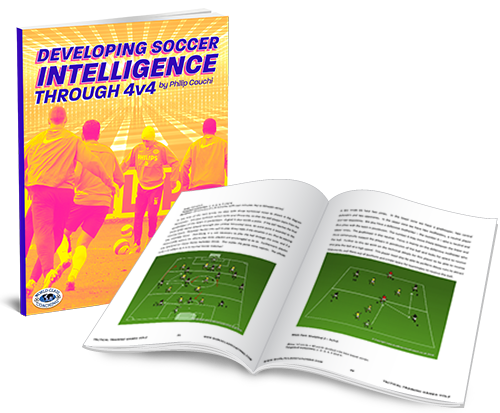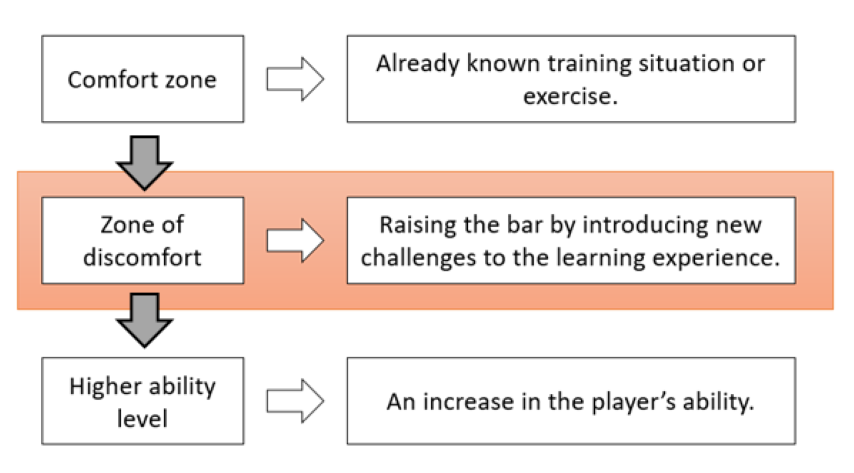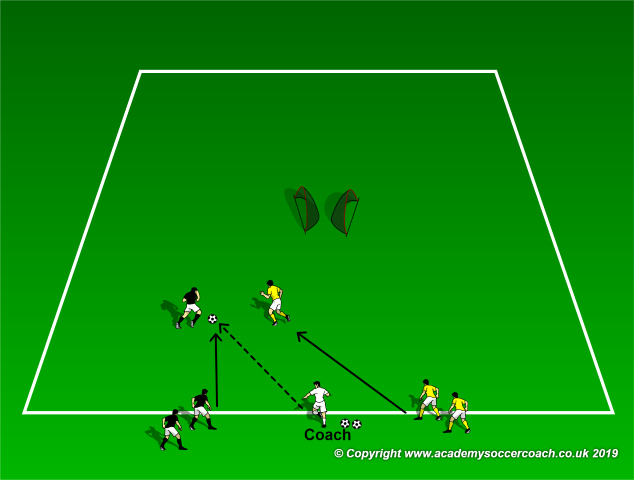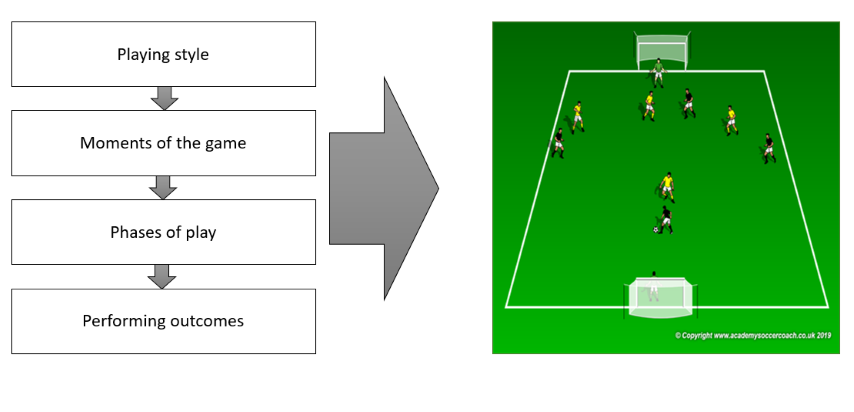WORLD CLASS COACHING
Developing Soccer Intelligence Through 4v4
By Philip Cauchi

Table of Contents
PART ONE
Introduction
Training Methodology
PART TWO
Various Uses of 4v4
4v4 as Part of the 11v11 Game
PART THREE
Game-Like Training
PART FOUR
Rondos to Develop Positional Awareness in 4v4
Introduction
The purpose of this book is to guide coaches towards creating successful training programmes based on the 4v4. Although the 4v4 is a great tool to work with the younger ages on honing their tactical intelligence while polishing their technical competence, it can also be utilised with advanced players working on more complex aspects of the game.
I do not take soccer coaching and training according to the participants’ age. My point of reference with players is their current level of ability. We can have an eight year old girl who is proficiently able to handle basic tactical soccer situations, while on the other hand we can have an eleven year old boy who is a total beginner. With the eight year old we should move on towards more complex situations, thus raising her bar and stretching her overall soccer competence level. With the eleven year old we could have to start with basic situations such as 4v1, 3v1 to score, or even a 3v0, thus working on developing his technique and composure while at the same time building the fundamental tactical understanding of the game.
In this book, various practices are presented which may be utilised with players bearing different soccer abilities. It is the coach who then decides how to use these practices. The coach may use a complete session, part of it, or modify the practices completely according to the necessities. The practices provided in this book are just a guideline for the coach. The idea here is to spark the ideas of the coach in creating specific practices for the needs of the players.
It is not how nice an exercise looks on paper, but how it can enhance the performance of the players. When evaluating a session, the coach should ask how the players responded to it. Was the session too easy? Was it too hard? Or was it of the right level? It might be a good idea to supply this self-analysis by asking the players how they themselves felt during the session. Furthermore, asking the players some questions about the main outcomes of the session will definitely give the coach a better insight about their understanding of the game. Video recording the training sessions and reviewing them from time to time will also help with notational analysis and see the improvement of the players, especially when compared with the same practices. This also applies to analysing match performances.
Long-term Planning
Long-term planning means programing the development of the soccer player throughout the phases and years. Every soccer association and high level academies should have a clear vision and direction. The path towards the top should be well-lit and guided. Every season, training program and sessions should target the achievement of particular outcomes that act as stepping stones towards reaching the final destination; i.e., to develop players towards reaching their maximum level of potential.
A soccer curriculum guides us in our planning and establishes continuity within the player’s development (Jozak, R. and Kepčija, I. 2018). Profiling should exist in such a way that the development of players and what they accomplish over the years is recorded. This will serve as a guideline for the coaches under which these players train during their career. Coaches should know the players and what level they are at, thus proper planning towards further advancement in their soccer development can be done.
Although repeating practices that the players are already familiar with is important to reinforce what they have already acquired, stretching the players’ abilities should be the ultimate target for every soccer coach. Every practice should be very effective in that the players always face challenges that further develops their ability to perceive and anticipate situations as well as selecting the most appropriate techniques to solve problems in the least possible time.
When planning a youth soccer curriculum, it is vital to pay attention to the sensitive phases of development. This means that during these phases, there is an acceleration in the learning or acquisition of a particular capacity (both motor, cognitive and technical) if properly trained. Adaptation to the respective skill or capacity occurs faster during this phase of development. Training programmes should take these sensitive phases into account (Aznar, D., Juanes, R., Dorado, M. and Gaspar F., 2014).
Training methodology
Training practices should be designed around the players’ capacity to perceive information from the environment, the view about themselves and how they interact with others (Jozak, R. and Kepčija, I. 2018). This points out the reason why training should be relevant to the game in a way that players learn to focus on the most relevant cues to build an accurate picture of the situation.
Nevertheless, the stimuli that we create in training should be related to the developmental age of the players. This is very important when planning sessions as an eight year old child perceives soccer differently than a twelve year old. An eight year old is more recipient towards training that involve individual development than small group tactical training. It is thus extremely important to recognise that individual training on how to receive the ball, turn with the ball, apply fakes and feints, etc. are more suitable than playing 4v4 with the emphasis on defending for the eight year old. The twelve year old will be more receptive towards small group tactics and is thus ready to learn more about the principles of play. Training at this age could be designed on the moments of the game with particular emphasis on specific tactical themes.
Every training session and practice are important in the development of players. These should thus be meaningful learning experiences for the players (Grima, 2016). It is not only how many ball contacts the players make during a session, but more importantly how immersed they are within realistic game situations that target the growth in all the soccer domains (technical, tactical, physical and mental). We can also include the social aspect with these. A soccer player is required to have good social and collaborative skills in order to succeed at the higher levels of the game.
Training practices should be game realistic at any level of ability. This does not mean that we have to train always with opponents. What it means is that the practices should be directly linked with specific situations that occur in a game. Exercises that are analytical and deal with the development of technique can be done. However, they should not take too much time from the total available for the training session (Mariman, H., Berger, H. and Coolen, L, 2015). With higher level players decision making becomes ever more important in developing game action speed. It is thus recommended that even when working on technique some aspect of decision-making should be present. This can be practicing both against a passive or semi-active defender/s, and/or under time pressure, where other constraints are present in exercises where creativity is allowed.
In our training sessions we should let our young aspiring soccer players know what the main aim is and what the required outcomes in order to achieve this aim are. These outcomes will guide us towards achieving the ultimate objective of the session. Explaining what the session is about and establish a brief discussion with the players prior to the training session is highly recommended (Mariman et al., 2015). Tactical boards and videos are great tools to use to demonstrate and discuss with the players the basic tactical principles. This is called ideomotor training where the players are guided through well-planned questioning to envision the tactical response to a situation described by the coach on the board (Jozak, R. and Kepčija, I. 2018).
At regular periods during the season we should review with the players what we have accomplished so far. This gives them a sense of achievement which in return motivates them for further learning. Every session we carry out on the training pitch should get us one step closer to the planned objectives. Training sessions should enable the players to experience game situations where the projected outcomes are clearly highlighted.
Training should be simple, yet guide the players towards achieving higher levels. We are therefore always in search of raising the players’ bar and stretching their technical, tactical, physical and mental abilities. This is imperative as we educate the nervous system to carry out both generic and specific motor tasks. Apart from this, game insight such as moving into the right space and at the right time to receive the ball will also be developed. We as coaches should make sure to select the right stimuli (exercises) at the right time of the players’ development. This way efficient learning can occur.
Every training session should start from a situation within which the players are familiar. The process in training sessions should guide them towards new or slightly modified situations. These are situations where the players get out of their comfort zone to experience, experiment and learn to acquire new soccer skills.

Practices should be frequently repeated. It is the most effective way that the players learn and it is also the most efficient as we do not waste precious time in every training session to explain new exercises. Within these practices we should however work in a random manner. No robotic patterns of play should take place, and if the need be they should be kept to a minimum. Within the same practice we can have variations where the players learn to apply the basic principles of play but within different situations while varying the resistance. It could be that a 1v1 is played with the defender facing the attacker, the defender and the attacker starting side by side, or the attacker receiving the ball with his back to the goal while being pressured by the defender from behind. The principles of individual attacking and defending are being stressed here but within different scenarios. This is known as repeating without repeating.
Training situations should be simple, yet bear specific and clear objectives. We do not need to complicate matters! The below diagram provides us with an example. Here we have a basic situation where the aim is to score a goal in either of the two goals positioned back to back. The rules are simple; to outplay the defender and score in either of the two mini goals.

When planning a training session we just need to focus on a few performing outcomes. These outcomes should be clearly selected and listed in a progressive manner that guide us towards achieving the main aim of the session.
When using small sided games we expose the players to frequent problems from which these outcomes are derived (Grima, 2017). In a game of 3v3 or 4v4 the problem and its associated principles of play and outcomes will be continuously repeated from different dimensions. This means that even if the problems are frequently repeated there is always uncertainty in the outcome of situations. Unlike drills where the outcome is already known as the solution for the problems has been given by the coach, in a small sided game it is the players themselves who must perceive the situation and select the most appropriate response.
In a small sided game all the elements of the global game are present. This means that the moments and phases of play, the principles of play and the performance outcomes are always there. Although we may use drills to reinforce the development of a particular technique, the ingredients that develop a holistic soccer player are left out. This means that in a drill we only concentrate on only one aspect without the players having to think for themselves. I am not saying that drills have to be completely abolished. However, we must dedicate appropriate time for them! Too much time devoted to drills will make the players completely reliant on the coach. Their problem solving skills will therefore be hindered.

Small sided games simplify the global game and make the phases of play much easier to develop. The outcomes that determine the success of a phase of play are also easily visible and manageable through small sided games. In these kind of games players have to continuously be focused and adjust according to the ever changing environment. This aids in the development of game insight and therefore the players will also develop their ability to anticipate situations.


